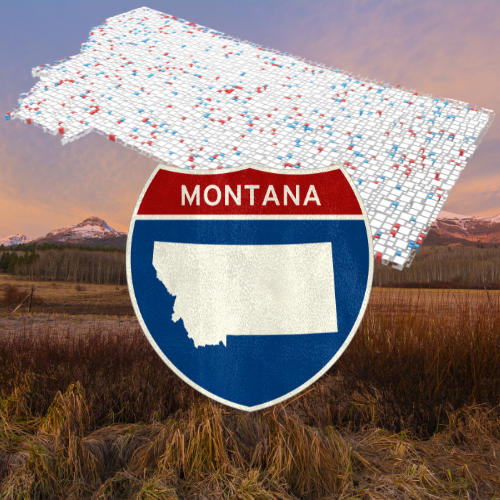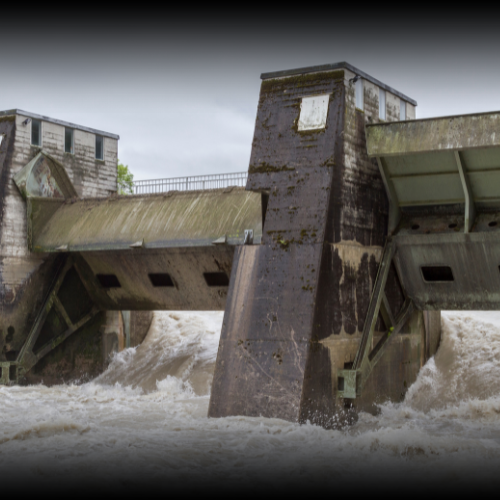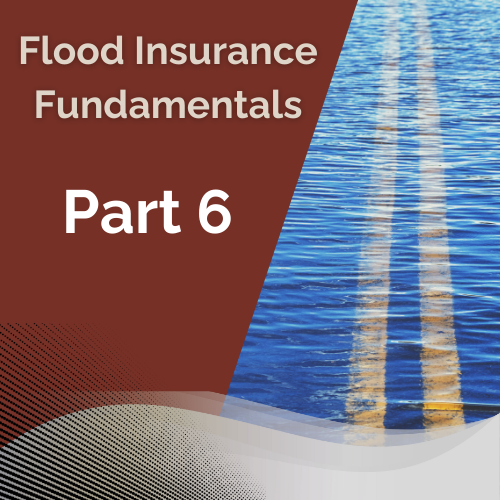Flood Insurance Fundamentals: Part 6

Operation: Discounts
Everybody loves a good discount and in Flood Insurance Fundamentals: Part 6, that is what we are talking about!
Discounts happen to be the third step in determining NFIP flood insurance rates: Other Policy Writing and Rating Considerations
- This part will cover:
- The Newly Mapped Discount
- The Pre-Firm Discount
- The Proper Flood Openings Discount
- The Machinery and Equipment Discount; and
- Policy Cancellation Rules
The Newly Mapped Discount

Like Magic
- A property may be eligible for the Newly Mapped discount if:
- It was once designated outside of the Special Flood Hazard Area (SFHA); and
- It is now designated within an SFHA, following a map revision
The discount applies to properties newly mapped into an SFHA from moderate to low-risk flood Zones B, C, X, or undetermined flood risk Zone D
The discount also applies to properties in A99 or AR zones newly mapped into a different SFHA
Fun Facts
FEMA determines the discount based on the current flood zone using the FIRM in effect at the time of application and payment
The eligibility period for the Newly Mapped discount is 12 months following a flood map revision
The discount phases out annually, subject to the statutory 18% cap, until the policy reaches its full-risk premium
The latest revision for your area can be found using FEMA’s NFIP Community Status Book found HERE
The Case Study
Let’s revisit our case study introduced in Part 3
A review of the NFIP’s Community Status Book shows the Current Effective Map Date for the Miles City, MT Community to be 07/22/2010 which is when the area received its digital mapping
Since it is more than 12 months past the revision date there is no chance of receiving this discount, even if the property had been designated in any of the Zones B, C, X, or D prior to the revision and after the revision had been designated to be in an SFHA
Pre-Firm Discount

Savings: Round 2
Remember in Part 2 we defined what a Pre-FIRM building is
A Pre-FIRM building is one that was constructed before the Flood Insurance Rate Map (FIRM) was initially established for the area
- A Pre-FIRM building is eligible for the Pre-FIRM discount if it meets the following criteria:
- Qualifies as a primary residence
- Is not a commercial property
- Is not designated a Severe Repetitive Loss (SRL) property
Fun Facts
The Pre-FIRM Discount phases out annually until the policy reaches its full-risk premium
The policy for the Pre-FIRM building is subject to statutory caps on annual premium increases, limited to 18%
Policyholders will lose the discount if there is a lapse in coverage, meaning that coverage expires or is no longer in effect
Back to the Case Study
We again review the NFIP Community Status Book and remind ourselves that the initial FIRM for Miles City, MT, was issued on 02/01/1980
We also know that the building is Pre-FIRM because it was built in 1975
The couple intends for the house to be their primary residence. It is a single-family home with two stories and a basement
Dose the Building Qualify?
- The building does qualify because:
- Building date (1975) pre-dates initial FIRM date (1980)
- Will be used for the couple’s primary residence
- It is not a commercial building
But what about the home’s history of flooding in 1978 and 2011?
Even though the property has experienced two flooding events, it is not considered a Severe Repetitive Loss Property (SRL)
As we learned in Part 4, an SRL property requires either four or more separate claims exceeding $5,000 each, with a cumulative amount exceeding $20,000, or at least two separate claims payments where the cumulative amount exceeds the building’s market value. Neither of these conditions has occurred
Therefore, we can conclude that the property qualifies for a Pre-FIRM Discount. Now lets move on to the Proper Flood Openings Discount
Proper Flood Openings Discount

Open the Flood Gates
Just a quick review of the concept of Elevated Buildings that we touched on in Part 4
In NFIP speak, an elevated building is a building that has no basement and has its lowest elevated floor raised above ground level by foundation walls, shear walls, posts, piers, pilings, or columns
Note: in Zones V and VE, solid foundation perimeter walls are unacceptable for elevated buildings
Enclosures
For elevated buildings, the NFIP considers an enclosure to be any portion of the elevated building below the lowest elevated floor that is partially or fully shut in by rigid walls
Any enclosure for an elevated building must have the proper flood openings to receive the Proper Flood Opening Discount
Proper Flood Opening Discount Requirements
Flood openings are required for elevated buildings with enclosures in Special Flood Hazard Areas (SFHAs) to automatically equalize hydrostatic pressure on exterior walls during flood events
Proper openings allow floodwaters to flow freely in and out, reducing the risk of foundation failure
Meeting these requirements can also lead to lower flood insurance premiums
- The requirements are
- They must automatically equalize flood forces by allowing entry and exit of flood waters
- A minimum of two openings on at least two exterior walls
- Total net area of not less than one square inch for every square foot of enclosure
- The bottoms of the openings are no higher than one foot above the higher of the exterior or interior grade
- Note: The enclosed space cannot be used for a living area. It can only be used for:
- Building Access
- Parking
- Storage
For the sake of being thorough, we will turn our attention to breakaway walls which are not used in Montana because we have no coasts
Breakaway Walls
Breakaway walls are designed to collapse under specific conditions, protecting the main structure from excessive flood forces
They are utilized in coastal high-hazard areas, where wave action and high-velocity water flow pose significant risks during flooding events
These walls are another element in flood-resistant design that can impact flood insurance rates in certain zones
- Breakaway Walls Are:
- Used in V zones (Coastal areas)
- Not part of a structural wall support
- Intended to collapse under certain lateral loading forces
- They are engineered to collapse without causing damage to the elevated portion of the building or the supporting foundation system
In NFIP flood insurance terms, properly designed breakaway walls can help property owners in V zones meet building code requirements and potentially qualify for more favorable insurance rates
Note: These walls must be certified by a registered professional engineer or architect to meet specific design criteria. Moving on!
Machinery & Equipment (M&E) Discount

Parked in its Happy Spot!
The NFIP provides a 5% mitigation discount for certain Machinery & Equipment that services the building, is in a qualified location relative to the building, and is fixed in place
- The M&E Discount Criteria
- FEMA’s rating engine applies the discount for policyholders with M&E elevated above their first floor
- Agents self-certify the position of the M&E by answering a “Yes/No” question on the application
- Eligible M&E Includes:
- Central air conditioner (including exterior compressor)
- Furnace
- Heat pump (including exterior compressor)
- Hot water heater
- Elevator machinery and equipment
- Clothes washers and dryers
- Food freezers (including food inside)
Note: While food in freezers is covered under the M&E discount, food inside refrigerators is not eligible for coverage, nor is the refrigerator
M&E Location Guidance
- For a Slab on Grade (Non-Elevated)
- One floor: Elevated at least to the height of the attic
- More than one floor: Elevated to the height of the second floor or higher
- For a Basement (Non-Elevated)
- Elevated to the height of the floor above the basement or higher
- For Elevated Without Enclosure on Posts, Piles, or Piers
- Elevated to the height of the lowest elevated floor or higher
- For Elevated With Enclosure on Posts, Piles, or Piers
- Elevated to the height of the lowest elevated floor or higher
- For Elevated with Enclosure Not Posts, Piles, or Piers
- Elevated to the height of the lowest elevated floor or higher
- Crawlspace (Elevated or Non-Elevated Subgrade Crawlspace)
- Elevated to the height of the floor above the crawlspace or higher
Inconsistency Alert
For all you sleuths out there, I know you noticed there are some big discrepancies regarding the M&E Location Guidance that just don’t make sense
Slab-on-Grade vs. Basement
Consider two identical houses in a Special Flood Hazard Area (SFHA) that sit beside each other with no significant change in grade
The only difference between the houses is that one has a basement and the other is slab on grade
- For the Slab on Grade (Non-Elevated) with one floor: The guidance requires M&E elevation at least to the height of the attic.
- For the Basement (Non-Elevated): The guidance only requires M&E elevation to the height of the floor above the basement or higher. That’s your first floor height
This creates a puzzling situation where the house with a basement, potentially more vulnerable to flooding, has a less stringent requirement for M&E elevation compared to the slab-on-grade house
Elevated with Enclosure vs. Crawlspace:
- Another inconsistency arises when comparing:
- Elevated with Enclosure Not Posts, Piles, or Piers: This refers to a home with a basement-like structure where at least one wall is exposed.
- The guidance requires M&E elevation to the height of the lowest elevated floor or higher.
- This could potentially be at the same level as a non-elevated basement and doesn’t require M&E to be in the attic like the slab-on-grade requirement.
- Crawlspace (Elevated or Non-Elevated Subgrade Crawlspace): The guidance requires M&E elevation to the height of the floor above the crawlspace or higher.
- A crawlspace is likely higher than a basement or elevated structure with enclosure not on posts, piles, or piers, but still lower than the attic or an elevated structure with enclosure on posts, piles, or piers
- Elevated with Enclosure Not Posts, Piles, or Piers: This refers to a home with a basement-like structure where at least one wall is exposed.
These discrepancies result in different M&E elevation requirements for structures that may have similar flood risks
The requirements don’t seem to correlate consistently with the actual flood risk of these different foundation types, which could lead to inadequate protection in some cases and overly stringent requirements in others
The Elusive Explanation: An Agent’s Opinion
I’ve looked high, and I’ve looked low. An answer to this quandary, nobody knows!
The differing requirements for slab-on-grade homes versus those with basements, as well as elevated structures with enclosures versus crawlspaces, lack clear justification
This raises questions about the effectiveness and fairness of the current guidelines, leaving policyholders and professionals to navigate these discrepancies without a solid rationale.
Until FEMA or the NFIP provides clarity, this enigma remains unresolved. Enough said, moving on
Cancellations

When the Policy Gets Ghosted
There are valid reasons for cancelling an NFIP policy. The NFIP recognizes 7 broad categories for cancellation reason codes
- Valid Reasons for Cancelling an NFIP Policy:
- No insurable interest
- Established a common expiration date
- Duplicated coverage
- Not eligible for coverage
- Lender no longer requires insurance
- Invalid payment or fraud
- Other reason codes
These 7 categories encompass all the legitimate reasons for cancelling an NFIP policy
Note: Cancellation requirements and procedures can vary depending on the specific reason and circumstances. Some cancellations may require FEMA approval, while others can be processed directly by the insurer. For detailed guidance on each reason code, refer to the NFIP Flood Insurance Manual
While cancellations involve terminating a policy for specific reasons, another important aspect of flood insurance management is understanding what happens when a policy lapses
Lapse in Coverage
NFIP policies are subject to the lapse in coverage rule
The Rule States:
A new policy with payment is required if a lapse in coverage occurs on or after 30 days following the policy expiration
- This means:
- Policy Expiration Date:
- The policy remains active until the end of the expiration date
- All policies expire at 12:01 am on the last day of the effective term
- Grace Period: The first 29 days after the expiration date allow policyholders to renew their policy without it lapsing
- Lapse Begins: On day 30, if the policy has not been renewed, it officially lapses
- Policy Expiration Date:
The lapse is applied regardless of who pays for the policy (payor)
- Any lapse in coverage may affect policy rating, including:
- Elimination of the Annual Increase Cap
- Loss of statutory discounts
We Have Covered A Lot!
- Today’s gems to file in the Vault
- Properties recently mapped into a Special Flood Hazard Area may be eligible for a Newly Mapped Discount
- Buildings with proper flood openings may receive a discount, but must meet certain criteria based on size, location, and number of openings
- Policyholders can receive a discount for proper placement of eligible machinery and equipment servicing a building
- Cancellations are allowed for a limited number of valid cancellation reasons in the NFIP
In Part 7 we will explore the Coverages, the Limitations, and the Exclusions contained in the Standard Flood Insurance Policy (SFIP)



Leave a Reply